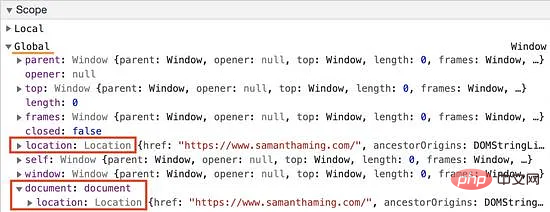Detailed explanation of window.location object in JS (cheat sheet)

If you want to get the URL information of the site, then the window.location object is suitable for you! Use its properties to get information about the current page address, or use its methods to do some page redirection or refresh
window.location.origin → '"https://segmentfault.com' .protocol → 'https:' .host → 'segmentfault.com' .hostname → 'segmentfault.com' .port → '' .pathname → '/search' .search → '?q=前端小智' .hash → '#2' .href → 'https://segmentfault.com/search?q=前端小智#2'
window.location.assign('url')
.replace('url')
.reload()
.toString()window.location property
| window.location | Return value |
|---|---|
| .origin | Site main address (protocol host name port ) |
| .protocol | Protocol architecture (http: or htts:) |
| .host | Domain name port |
| .port | Port |
| .pathname | The path followed by '/' on the first page |
| .search | ? The query string followed |
| .hash | Part starting from |
| #.href | Full URL |
The difference between host and hostname
In the above example, you may notice that host and hostnameReturn the same value. So why these properties. Well, it's about the port number, so let's take a look.
URL without port
https://segmentfault.com/search
window.location.host; // 'segmentfault.com' window.location.hostname; // 'segmentfault.com' window.location.port; // ''
URL with port
##https://segmentfault.com/search"8080Therefore,window.location.host; // 'segmentfault.com:8080' window.location.hostname; // 'segmentfault.com' window.location.port; // '8080'Copy after login
host will include the port number, while hostname will return only the host name.
How to change URL properties
Not only can we call the location` attribute to retrieve URL information, we can also use it to set new properties and change the URL.// 开始 'https://segmentfault.com/' window.location.pathname = '/tidbits'; // 设置 pathname // 结果 'https://segmentfault.com/tidbits'
// 事例 window.location.protocol = 'https' .host = 'localhost:8080' .hostname = 'localhost' .port = '8080' .pathname = 'path' .search = 'query string' // (这里不用写 `?`) .hash = 'hash' // (这里不用写 `#`) .href = 'url'
window.location.origin, which is read-only.
Location object
window.location Returns a Location object. It gives us information about the current address of the page. But we can also access the Location object in several ways.
window.location → Location window.document.location → Location document.location → Location location → Location

window.location vs location
The above four properties all point to the sameLocation object. I personally prefer window.location and would actually avoid using location. Mainly because location looks like a normal variable, and we may sometimes accidentally name it as a variable, which will override the global variable. For example:
// https://www.samanthaming.com
location.protocol; // 'https'
function localFile() {
const location = '/sam';
return location.protocol;
// undefined
// b/c local "location" has override the global variable
}window is a global variable. That way it's less likely to cause confusion. To be honest, I didn't know location## until I wrote this article # is a global variable. It is recommended that you use window.location instead of other writing methods.
window.location method
| Function | |
|---|---|
| .replace() | |
| .reload() | |
| .reload() | |
The above is the detailed content of Detailed explanation of window.location object in JS (cheat sheet). For more information, please follow other related articles on the PHP Chinese website!

Hot AI Tools

Undresser.AI Undress
AI-powered app for creating realistic nude photos

AI Clothes Remover
Online AI tool for removing clothes from photos.

Undress AI Tool
Undress images for free

Clothoff.io
AI clothes remover

Video Face Swap
Swap faces in any video effortlessly with our completely free AI face swap tool!

Hot Article

Hot Tools

Notepad++7.3.1
Easy-to-use and free code editor

SublimeText3 Chinese version
Chinese version, very easy to use

Zend Studio 13.0.1
Powerful PHP integrated development environment

Dreamweaver CS6
Visual web development tools

SublimeText3 Mac version
God-level code editing software (SublimeText3)

Hot Topics
 How to implement an online speech recognition system using WebSocket and JavaScript
Dec 17, 2023 pm 02:54 PM
How to implement an online speech recognition system using WebSocket and JavaScript
Dec 17, 2023 pm 02:54 PM
How to use WebSocket and JavaScript to implement an online speech recognition system Introduction: With the continuous development of technology, speech recognition technology has become an important part of the field of artificial intelligence. The online speech recognition system based on WebSocket and JavaScript has the characteristics of low latency, real-time and cross-platform, and has become a widely used solution. This article will introduce how to use WebSocket and JavaScript to implement an online speech recognition system.
 WebSocket and JavaScript: key technologies for implementing real-time monitoring systems
Dec 17, 2023 pm 05:30 PM
WebSocket and JavaScript: key technologies for implementing real-time monitoring systems
Dec 17, 2023 pm 05:30 PM
WebSocket and JavaScript: Key technologies for realizing real-time monitoring systems Introduction: With the rapid development of Internet technology, real-time monitoring systems have been widely used in various fields. One of the key technologies to achieve real-time monitoring is the combination of WebSocket and JavaScript. This article will introduce the application of WebSocket and JavaScript in real-time monitoring systems, give code examples, and explain their implementation principles in detail. 1. WebSocket technology
 How to use JavaScript and WebSocket to implement a real-time online ordering system
Dec 17, 2023 pm 12:09 PM
How to use JavaScript and WebSocket to implement a real-time online ordering system
Dec 17, 2023 pm 12:09 PM
Introduction to how to use JavaScript and WebSocket to implement a real-time online ordering system: With the popularity of the Internet and the advancement of technology, more and more restaurants have begun to provide online ordering services. In order to implement a real-time online ordering system, we can use JavaScript and WebSocket technology. WebSocket is a full-duplex communication protocol based on the TCP protocol, which can realize real-time two-way communication between the client and the server. In the real-time online ordering system, when the user selects dishes and places an order
 How to implement an online reservation system using WebSocket and JavaScript
Dec 17, 2023 am 09:39 AM
How to implement an online reservation system using WebSocket and JavaScript
Dec 17, 2023 am 09:39 AM
How to use WebSocket and JavaScript to implement an online reservation system. In today's digital era, more and more businesses and services need to provide online reservation functions. It is crucial to implement an efficient and real-time online reservation system. This article will introduce how to use WebSocket and JavaScript to implement an online reservation system, and provide specific code examples. 1. What is WebSocket? WebSocket is a full-duplex method on a single TCP connection.
 JavaScript and WebSocket: Building an efficient real-time weather forecasting system
Dec 17, 2023 pm 05:13 PM
JavaScript and WebSocket: Building an efficient real-time weather forecasting system
Dec 17, 2023 pm 05:13 PM
JavaScript and WebSocket: Building an efficient real-time weather forecast system Introduction: Today, the accuracy of weather forecasts is of great significance to daily life and decision-making. As technology develops, we can provide more accurate and reliable weather forecasts by obtaining weather data in real time. In this article, we will learn how to use JavaScript and WebSocket technology to build an efficient real-time weather forecast system. This article will demonstrate the implementation process through specific code examples. We
 Simple JavaScript Tutorial: How to Get HTTP Status Code
Jan 05, 2024 pm 06:08 PM
Simple JavaScript Tutorial: How to Get HTTP Status Code
Jan 05, 2024 pm 06:08 PM
JavaScript tutorial: How to get HTTP status code, specific code examples are required. Preface: In web development, data interaction with the server is often involved. When communicating with the server, we often need to obtain the returned HTTP status code to determine whether the operation is successful, and perform corresponding processing based on different status codes. This article will teach you how to use JavaScript to obtain HTTP status codes and provide some practical code examples. Using XMLHttpRequest
 How to use insertBefore in javascript
Nov 24, 2023 am 11:56 AM
How to use insertBefore in javascript
Nov 24, 2023 am 11:56 AM
Usage: In JavaScript, the insertBefore() method is used to insert a new node in the DOM tree. This method requires two parameters: the new node to be inserted and the reference node (that is, the node where the new node will be inserted).
 JavaScript and WebSocket: Building an efficient real-time image processing system
Dec 17, 2023 am 08:41 AM
JavaScript and WebSocket: Building an efficient real-time image processing system
Dec 17, 2023 am 08:41 AM
JavaScript is a programming language widely used in web development, while WebSocket is a network protocol used for real-time communication. Combining the powerful functions of the two, we can create an efficient real-time image processing system. This article will introduce how to implement this system using JavaScript and WebSocket, and provide specific code examples. First, we need to clarify the requirements and goals of the real-time image processing system. Suppose we have a camera device that can collect real-time image data






